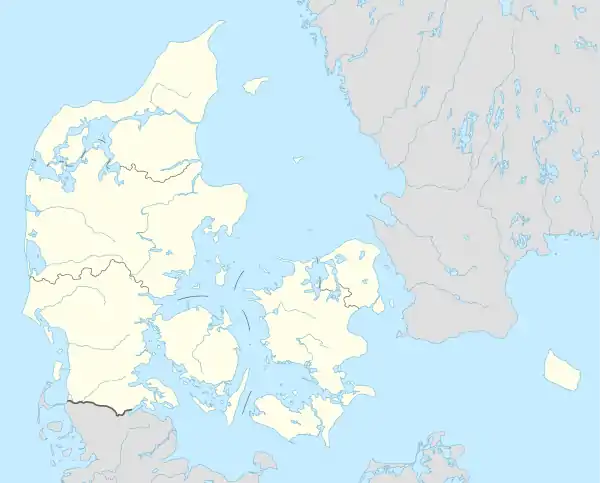This is a list of urban areas in Denmark by population. For a list on cities in Denmark please see List of cities in Denmark by population.
The population is measured by Statistics Denmark for urban areas (Danish: byområder or bymæssige områder), which is defined as a contiguous built-up area with a maximum distance of 200 m between houses, unless further distance is caused by public areas, cemeteries or similar reasons. Furthermore, to obtain by-status, the area must have at least 200 inhabitants.[1] Some urban areas in Denmark have witnessed conurbation and grown together.

Copenhagen
Aarhus
Odense
Aalborg
Esbjerg
Randers
Kolding
Horsens
Vejle
Roskilde
Herning
Silkeborg
Location of the most populous urban areas in Denmark
 Population of 1,000,000+ (Copenhagen)
Population of 1,000,000+ (Copenhagen)
 100,000+ (Aarhus, Odense and Aalborg)
100,000+ (Aarhus, Odense and Aalborg)
 50,000+ (Esbjerg, Herning, Horsens, Kolding, Randers, Roskilde, Silkeborg, and Vejle)
50,000+ (Esbjerg, Herning, Horsens, Kolding, Randers, Roskilde, Silkeborg, and Vejle)
 20,000+ (24 cities, unlabeled)
20,000+ (24 cities, unlabeled)
| # | Diff. | City/urban area | Population |
|---|---|---|---|
| 1 | Urban Copenhagen (Hovedstadsområdet)[note 1]
|
1,363,296 | |
| 2 | Aarhus | 290,598 | |
| 3 | Odense | 182,387 | |
| 4 | Aalborg | 120,914 | |
| 5 | Esbjerg | 71,921 | |
| 6 | Randers | 64,057 | |
| 7 | Horsens | 63,162 | |
| 8 | Kolding | 62,338 | |
| 9 | Vejle | 61,310 | |
| 10 | Roskilde | 52,580 | |
| 11 | Herning | 51,193 | |
| 12 | Silkeborg | 50,866 | |
| 13 | Hørsholm | 47,836 | |
| 14 | Helsingør (Elsinore) | 47,563 | |
| 15 | Næstved | 44,996 | |
| 16 | Viborg | 42,234 | |
| 17 | Fredericia | 41,243 | |
| 18 | Køge | 38,588 | |
| 19 | Holstebro | 37,022 | |
| 20 | Taastrup | 36,193 | |
| 21 | Hillerød | 36,043 | |
| 22 | Slagelse | 34,648 | |
| 23 | Holbæk | 29,960 | |
| 24 | Sønderborg | 28,137 | |
| 25 | Svendborg | 27,594 | |
| 26 | Hjørring | 25,917 | |
| 27 | Nørresundby | 23,830 | |
| 28 | Ringsted | 23,498 | |
| 29 | Ølstykke-Stenløse | 23,130 | |
| 30 | Frederikshavn | 22,961 | |
| 31 | Haderslev | 22,182 | |
| 32 | Smørumnedre | 21,353 | |
| 33 | Birkerød | 20,853 | |
| 34 | Farum | 20,317 | |
| 35 | Skive | 20,176 | |
| 36 | Skanderborg | 20,079 |
See also
- Largest metropolitan areas in the Nordic countries
- List of metropolitan areas in Sweden
- List of urban areas in Sweden by population
- List of urban areas in Norway by population
- List of urban areas in the Nordic countries
- List of urban areas in Finland by population
- List of cities in Iceland
- World's largest cities
Notes
- ↑ Hovedstadsområdet consists of the municipalities of Copenhagen, Frederiksberg, Albertslund, Brøndby, Gentofte, Gladsaxe, Glostrup, Herlev, Hvidovre, Lyngby-Taarbæk, Rødovre, Tårnby and Vallensbæk as well as parts of Ballerup, Rudersdal and Furesø municipalities, along with the cities of Ishøj and Greve.
References
- ↑ "Urban Areas: Statistical presentation". dst.dk. Statistics Denmark. Retrieved 4 June 2023.
- ↑ "BY1: Population 1. January by urban areas, age and sex". statbank.dk. Statistics Denmark. Retrieved 4 June 2023.
This article is issued from Wikipedia. The text is licensed under Creative Commons - Attribution - Sharealike. Additional terms may apply for the media files.